A Novel Deep Stack-Based Ensemble Learning Approach for Fault Detection and Classification in Photovoltaic Arrays
Abstract
1. Introduction
- Designing a novel deep stack-based ensemble learning (DSEL) approach for PV-fault diagnosis with deep base learners based on a probabilistic strategy without intensive hyperparameter tuning;
- A thorough review of fault-diagnosis techniques published in earlier studies has been conducted to better comprehend the effectiveness and performance of the proposed DSEL approach compared to other methods;
- The key features have been collected by examining the fluctuations in the I–V characteristic curves of PV arrays under normal and fault conditions;
- The proposed DSEL methodology can identify and categorize defects through many critical scenarios with high impedances, low mismatch, irradiance levels, etc.
2. Description of PV System and Related Faults
2.1. Modelling of the PV Array
| Parameter | Values |
|---|---|
| Short-Circuit Current | 3.87 (A) |
| Maximum Current | 3.56 (A) |
| Open Circuit Voltage | 42.1 (V) |
| Maximum Voltage | 33.7 (V) |
| Maximum Power | 120 (W) |
| Maximum Series Fuse Rating | 10a |
| Operating Temperature | (−40~+85) °C |
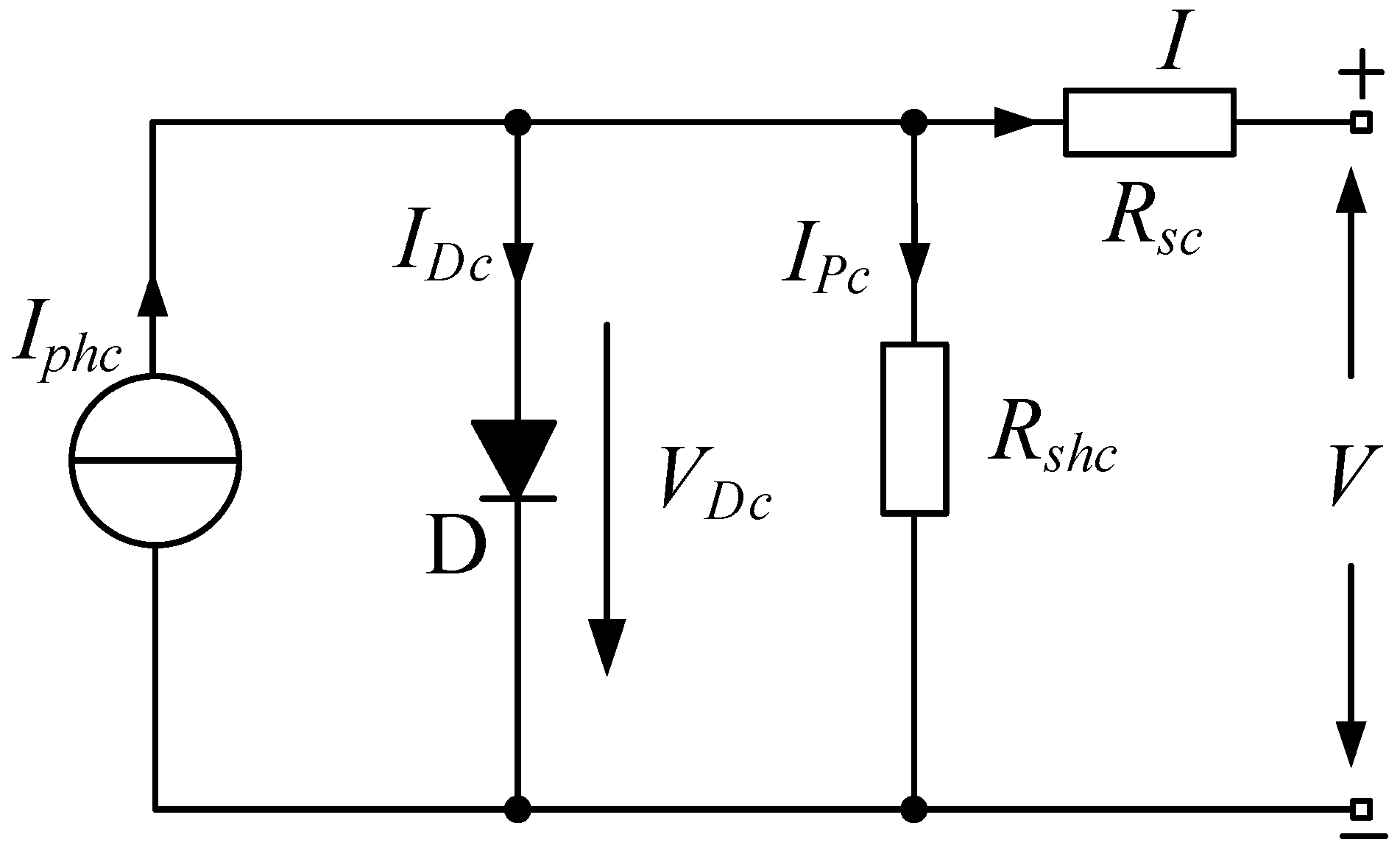
2.2. Fault Analysis in PV System
2.2.1. Open Circuit Fault
2.2.2. Short-Circuit Fault
2.2.3. Bridge Fault
2.2.4. Partial Shading Fault
2.2.5. Degradation Fault
3. Proposed Fault-Diagnosis Model
3.1. Data Acquisition and Preprocessing
3.2. Ensemble Learning-Based Algorithms
3.2.1. Ensemble Learning (EL)
3.2.2. Stacking
3.3. Framework of Proposed Fault-Diagnosis Algorithm
3.3.1. Deep Neural Network (DNN)
3.3.2. LSTM
3.3.3. Bidirectional LSTM
3.4. Development of Base Learners and Meta-Learner for Proposed Algorithm
3.4.1. Architecture of DNN
3.4.2. Architecture of LSTM
3.4.3. Architecture of Bi-LSTM
3.4.4. Architecture of Multinomial Logistic Regression
3.5. Training and Testing
3.6. Development Setup
4. Results Evaluation and Discussion
4.1. Performance Measure Based on Noiseless Data
4.2. Performance Measurements Based on Noisy Dataset
5. Conclusions
Author Contributions
Funding
Conflicts of Interest
References
- Wang, L.; Lodhi, E.; Yang, P.; Qiu, H.; Rehman, W.U.; Lodhi, Z.; Tamir, T.S.; Khan, M.A. Adaptive Local Mean Decomposition and Multiscale-Fuzzy Entropy-Based Algorithms for the Detection of DC Series Arc Faults in PV Systems. Energies 2022, 15, 3608. [Google Scholar] [CrossRef]
- Aghaei, M.; Fairbrother, A.; Gok, A.; Ahmad, S.; Kazim, S.; Lobato, K.; Oreski, G.; Reinders, A.; Schmitz, J.; Theelen, M.; et al. Review of degradation and failure phenomena in photovoltaic modules. Renew. Sustain. Energy Rev. 2022, 159, 112160. [Google Scholar] [CrossRef]
- Hojabri, M.; Kellerhals, S.; Upadhyay, G.; Bowler, B. IoT-Based PV Array Fault Detection and Classification Using Embedded Supervised Learning Methods. Energies 2022, 15, 2097. [Google Scholar] [CrossRef]
- Gielen, D.; Boshell, F.; Saygin, D.; Bazilian, M.D.; Wagner, N.; Gorini, R. The role of renewable energy in the global energy transformation. Energy Strategy Rev. 2019, 24, 38–50. [Google Scholar] [CrossRef]
- Daher, D.H.; Gaillard, L.; Ménézo, C. Experimental assessment of long-term performance degradation for a PV power plant operating in a desert maritime climate. Renew. Energy 2022, 187, 44–55. [Google Scholar] [CrossRef]
- Khoshnami, A.; Sadeghkhani, I. Fault detection for PV systems using Teager–Kaiser energy operator. Electron. Lett. 2018, 54, 1342–1344. [Google Scholar] [CrossRef]
- Shahsavari, A.; Akbari, M. Potential of solar energy in developing countries for reducing energy-related emissions. Renew. Sustain. Energy Rev. 2018, 90, 275–291, ISSN 1364-0321. [Google Scholar] [CrossRef]
- Lodhi, E.; Yang, P.; Wang, L.; Lodhi, Z.; Khan, M.A.; Muhammad, S.; Tamir, T.S. Modelling and Experimental Characteristics of Photovoltaic Modules in Typical Days at an Actual Photovoltaic Power Station, Proceedings of the IEEE 4th International Conference on Automation, Electronics and Electrical Engineering (AUTEEE), Shenyang, China, 19–21 November 2021; IEEE: New York, NY, USA, 2021. [Google Scholar] [CrossRef]
- Kerrouche, K.D.E.; Lodhi, E.; Kerrouche, M.B.; Wang, L.; Zhu, F.; Xiong, G. Modeling and design of the improved D-STATCOM control for power distribution grid. SN Appl. Sci. 2020, 2, 1519. [Google Scholar] [CrossRef]
- Lodhi, E.; Jing, S.; Lodhi, Z.; Shafqat, R.N.; Ali, M. Rapid and Efficient MPPT Technique with Competency of High Accurate Power Tracking for PV System, Proceedings of the 2017 4th International Conference on Information Science and Control Engineering (ICISCE), Changsha, China, 21–23 July 2017; IEEE: New York, NY, USA, 2017; pp. 1099–1103. [Google Scholar] [CrossRef]
- Firth, S.K.; Lomas, K.J.; Rees, S.J. A simple model of PV system performance and its use in fault detection. Sol. Energy 2010, 84, 624–635. [Google Scholar] [CrossRef]
- Zhao, Y.; De Palma, J.-F.; Mosesian, J.; Lyons, R.; Lehman, B. Line–Line Fault Analysis and Protection Challenges in Solar Photovoltaic Arrays. IEEE Trans. Ind. Electron. 2012, 60, 3784–3795. [Google Scholar] [CrossRef]
- Madeti, S.R.; Singh, S.N. Modeling of PV system based on experimental data for fault detection using kNN method. Sol. Energy 2018, 173, 139–151. [Google Scholar] [CrossRef]
- Lodhi, E.; Lina, W.; Pu, Y.; Javed, M.Y.; Lodhi, Z.; Zhijie, J.; Javed, U. Performance Evaluation of Faults in a Photovoltaic Array Based on VI and VP Characteristic Curve, Proceedings of the 2020 12th International Conference on Measuring Technology and Mechatronics Automation (ICMTMA), Phuket, Thailand, 28–29 February 2020; IEEE: New York, NY, USA, 2020. [Google Scholar]
- Pillai, D.S.; Rajasekar, N. An MPPT-Based Sensorless Line–Line and Line–Ground Fault Detection Technique for PV Systems. IEEE Trans. Power Electron. 2018, 34, 8646–8659. [Google Scholar] [CrossRef]
- Kumar, B.P.; Ilango, G.S.; Reddy, M.J.B.; Chilakapati, N. Online Fault Detection and Diagnosis in Photovoltaic Systems Using Wavelet Packets. IEEE J. Photovolt. 2018, 8, 257–265. [Google Scholar] [CrossRef]
- Schirone, L.; Califano, F.P.; Moschella, U.; Rocca, U. Fault finding in a 1 MW photovoltaic plant by refectometry. In Proceedings of the 1994 IEEE 1st World Conference on Photovoltaic Energy Conversion-WCPEC (a Joint Conference of PVSC, PVSEC and PSEC), Waikoloa, HI, USA, 5–9 December 1994; Volume 1, pp. 846–849. [Google Scholar]
- Roy, S.; Alam, M.K.; Khan, F.; Johnson, J.; Flicker, J. An irradiance independent, robust ground-fault detection scheme for PV arrays based on spread spectrum time-domain refectometry (SSTDR). IEEE Trans. Power Electron. 2018, 33, 7046–7057. [Google Scholar] [CrossRef]
- Jenitha, P.; Selvakumar, A.I. Fault detection in PV systems. Appl. Sol. Energy 2017, 53, 229–237. [Google Scholar] [CrossRef]
- Khoshnami, A.; Sadeghkhani, I. Sample entropy-based fault detection for photovoltaic arrays. IET Renew. Power Gener. 2018, 12, 1966–1976. [Google Scholar] [CrossRef]
- Kuo, C.-L.; Chen, J.-L.; Chen, S.-J.; Kao, C.-C.; Yau, H.-T.; Lin, C.-H. Photovoltaic energy conversion system fault detection using fractional-order color relation classier in microdistribution systems. IEEE Trans. Smart Grid 2017, 8, 1163–1172. [Google Scholar] [CrossRef]
- Hariharan, R.; Chakkarapani, M.; Ilango, G.S.; Nagamani, C. A method to detect photovoltaic array faults and partial shading in PV systems. IEEE J. Photovolt. 2016, 6, 1278–1285. [Google Scholar] [CrossRef]
- Yi, Z.; Etemadi, A.H. Line-to-Line Fault Detection for Photovoltaic Arrays Based on Multiresolution Signal Decomposition and Two-Stage Support Vector Machine. IEEE Trans. Ind. Electron. 2017, 64, 8546–8556. [Google Scholar] [CrossRef]
- Chen, Z.; Wu, L.; Cheng, S.; Lin, P.; Wu, Y.; Lin, W. Intelligent fault diagnosis of photovoltaic arrays based on optimized kernel extreme learning machine and I–V characteristics. Appl. Energy 2017, 204, 912–931. [Google Scholar] [CrossRef]
- Momeni, H.; Sadoogi, N.; Farrokhifar, M.; Gharibeh, H.F. Fault Diagnosis in Photovoltaic Arrays Using GBSSL Method and Proposing a Fault Correction System. IEEE Trans. Ind. Inform. 2020, 16, 5300–5308. [Google Scholar] [CrossRef]
- Samara, S.; Natsheh, E. Intelligent Real-Time Photovoltaic Panel Monitoring System Using Artificial Neural Networks. IEEE Access 2019, 7, 50287–50299. [Google Scholar] [CrossRef]
- Dairi, A.; Harrou, F.; Sun, Y.; Khadraoui, S. Short-Term Forecasting of Photovoltaic Solar Power Production Using Variational Auto-Encoder Driven Deep Learning Approach. Appl. Sci. 2020, 10, 8400. [Google Scholar] [CrossRef]
- Nitisanon, S.; Hoonchareon, N. Solar Power Forecast with Weather Classification Using Self-Organized Map. In Proceedings of the 2017 IEEE Power & Energy Society General Meeting, Chicago, IL, USA, 16–20 July 2017. [Google Scholar] [CrossRef]
- De, V.; Teo, T.T.; Woo, W.L.; Logenthiran, T. Photovoltaic power forecasting using LSTM on limited dataset. In Proceedings of the 2018 IEEE Innovative Smart Grid Technologies-Asia (ISGT Asia), Singapore, 22–25 May 2018; pp. 710–715. [Google Scholar] [CrossRef]
- Akram, M.N.; Lotfifard, S. Modeling and Health Monitoring of DC Side of Photovoltaic Array. IEEE Trans. Sustain. Energy 2015, 6, 1245–1253. [Google Scholar] [CrossRef]
- Ahmad, S.; Hasan, N.; Kurukuru, V.B.; Khan, M.A.; Haque, A. Fault classification for single phase photovoltaic systems using machine learning techniques. In Proceedings of the 2018 8th IEEE India International Conference on Power Electronics (IICPE), Jaipur, India, 13–15 December 2018; pp. 1–6. [Google Scholar]
- Chen, Z.; Chen, Y.; Wu, L.; Cheng, S.; Lin, P. Deep residual network based fault detection and diagnosis of photovoltaic arrays using current-voltage curves and ambient conditions. Energy Convers. Manag. 2019, 198, 111793. [Google Scholar] [CrossRef]
- Lodhi, E.; Wang, F.-Y.; Xiong, G.; Dilawar, A.; Tamir, T.S.; Ali, H. An AdaBoost Ensemble Model for Fault Detection and Classification in Photovoltaic Arrays. IEEE J. Radio Freq. Identif. 2022, 6, 794–800. [Google Scholar] [CrossRef]
- Aziz, F.; Haq, A.U.; Ahmad, S.; Mahmoud, Y.; Jalal, M.; Ali, U. A Novel Convolutional Neural Network-Based Approach for Fault Classification in Photovoltaic Arrays. IEEE Access 2020, 8, 41889–41904. [Google Scholar] [CrossRef]
- Basnet, B.; Chun, H.; Bang, J. An Intelligent Fault Detection Model for Fault Detection in Photovoltaic Systems. J. Sens. 2020, 2020, 6960328. [Google Scholar] [CrossRef]
- Wang, Z.-Y.; Lu, C.; Zhou, B. Fault diagnosis for rotary machinery with selective ensemble neural networks. Mech. Syst. Signal Process. 2018, 113, 112–130. [Google Scholar] [CrossRef]
- Ahmad, M.W.; Mourshed, M.; Rezgui, Y. Tree-based ensemble methods for predicting PV power generation and their comparison with support vector regression. Energy 2018, 164, 465–474. [Google Scholar] [CrossRef]
- Raza, M.Q.; Mithulananthan, N.; Li, J.; Lee, K.Y.; Gooi, H.B.; Nadarajah, M. An Ensemble Framework for Day-Ahead Forecast of PV Output Power in Smart Grids. IEEE Trans. Ind. Inform. 2018, 15, 4624–4634. [Google Scholar] [CrossRef]
- Zhou, Z.-H. Ensemble Methods: Foundations and Algorithms; CRC Press: Boca Raton, FL, USA, 2012. [Google Scholar] [CrossRef]
- De Guia, J.D.; Concepcion, R.S.; Calinao, H.A.; Lauguico, S.C.; Dadios, E.P.; Vicerra, R.R.P. Application of Ensemble Learning with Mean Shift Clustering for Output Profile Classification and Anomaly Detection in Energy Production of Grid-Tied Photovoltaic System. In Proceedings of the 2020 12th International Conference on Information Technology and Electrical Engineering (ICITEE), Yogyakarta, Indonesia, 6–8 October 2020; pp. 286–291. [Google Scholar] [CrossRef]
- Wu, Y.; Chen, Z.; Wu, L.; Lin, P.; Cheng, S.; Lu, P. An Intelligent Fault Diagnosis Approach for PV Array Based on SA-RBF Kernel Extreme Learning Machine. Energy Procedia 2017, 105, 1070–1076. [Google Scholar] [CrossRef]
- Kapucu, C.; Cubukcu, M. A supervised ensemble learning method for fault diagnosis in photovoltaic strings. Energy 2021, 227, 120463. [Google Scholar] [CrossRef]
- Lodhi, E.; Wang, F.-Y.; Xiong, G.; Mallah, G.A.; Javed, M.Y.; Tamir, T.S.; Gao, D.W. A Dragonfly Optimization Algorithm for Extracting Maximum Power of Grid-Interfaced PV Systems. Sustainability 2021, 13, 10778. [Google Scholar] [CrossRef]
- Hameed, Z.; Garcia-Zapirain, B. Sentiment Classification Using a Single-Layered BiLSTM Model. IEEE Access 2020, 8, 73992–74001. [Google Scholar] [CrossRef]
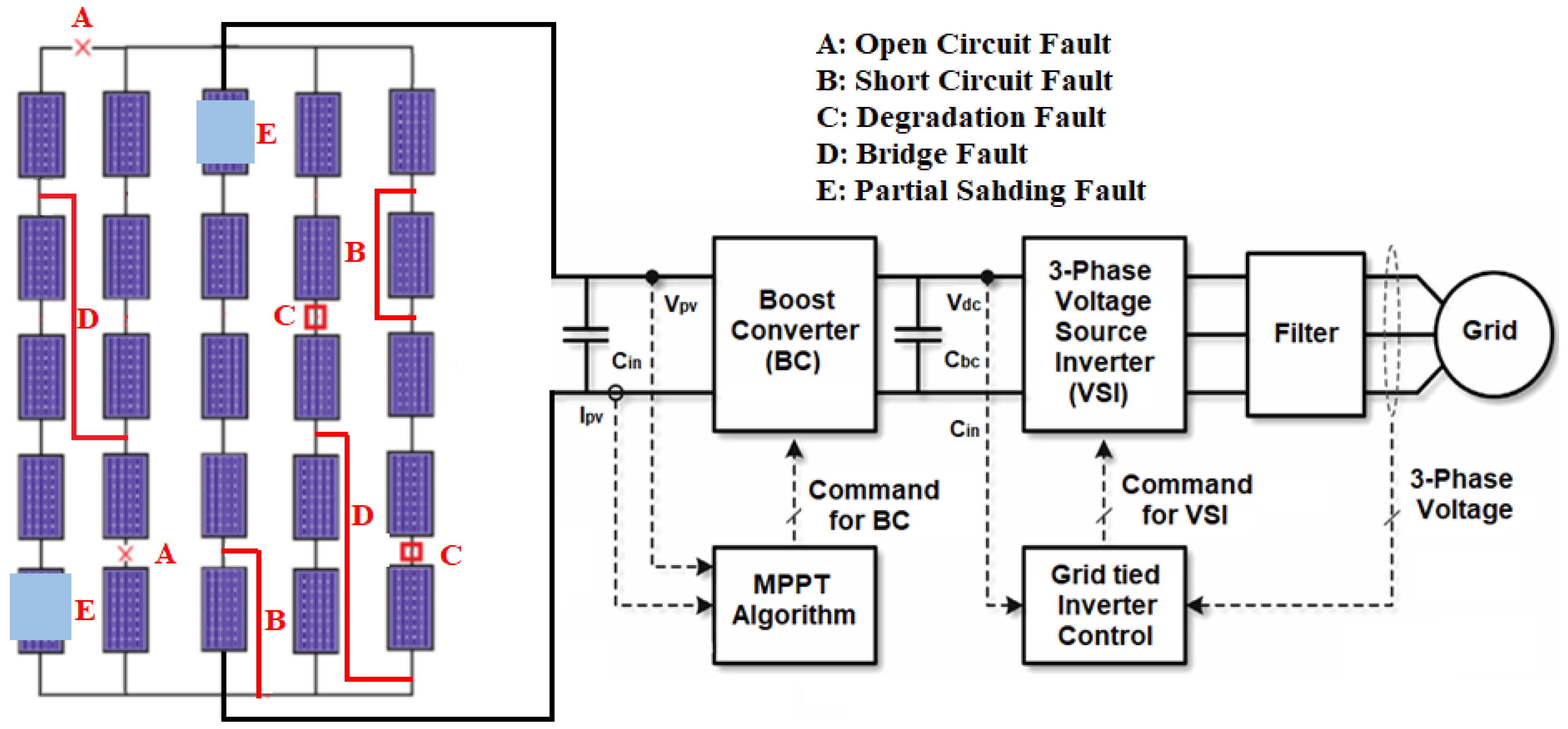


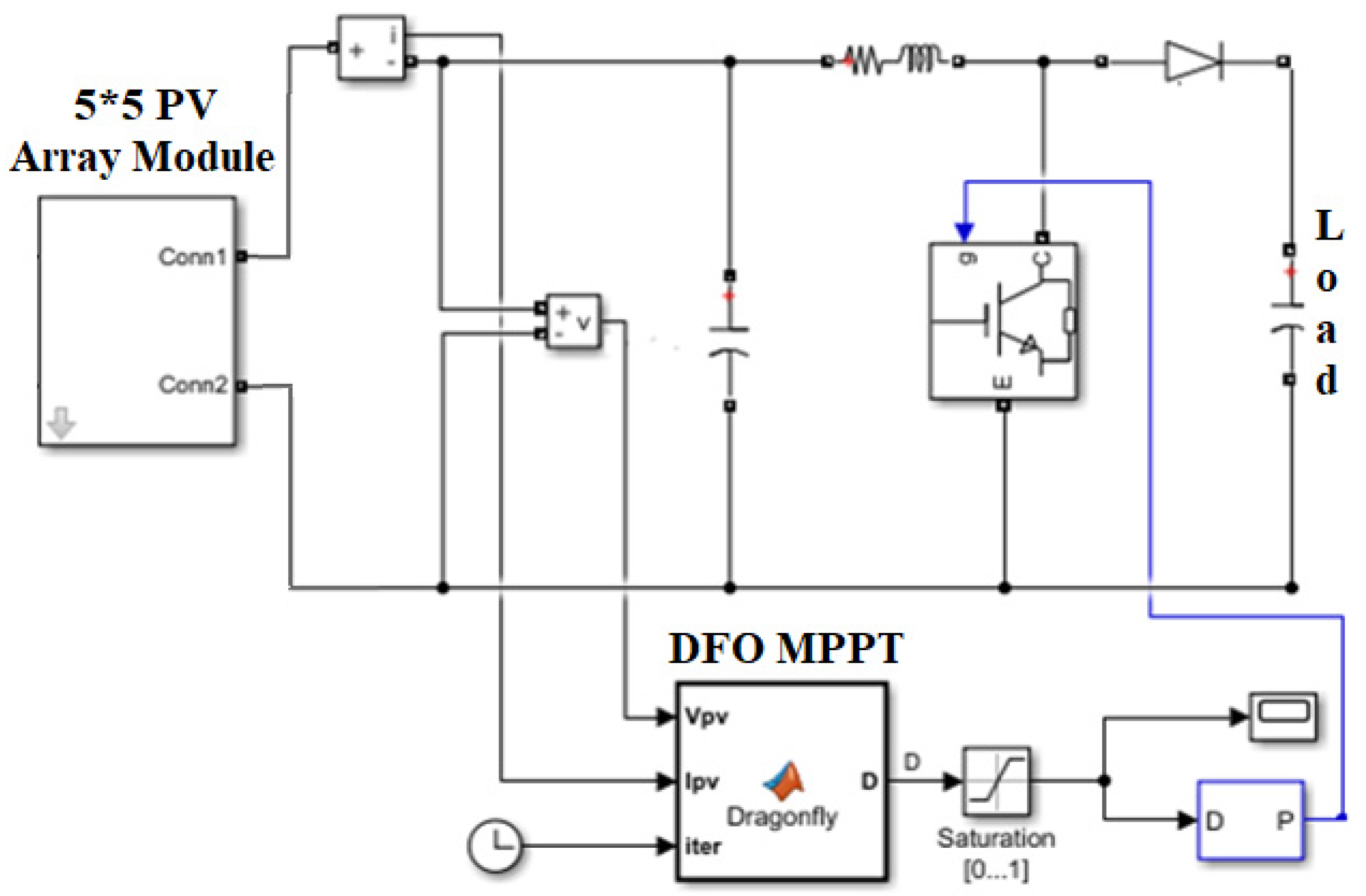
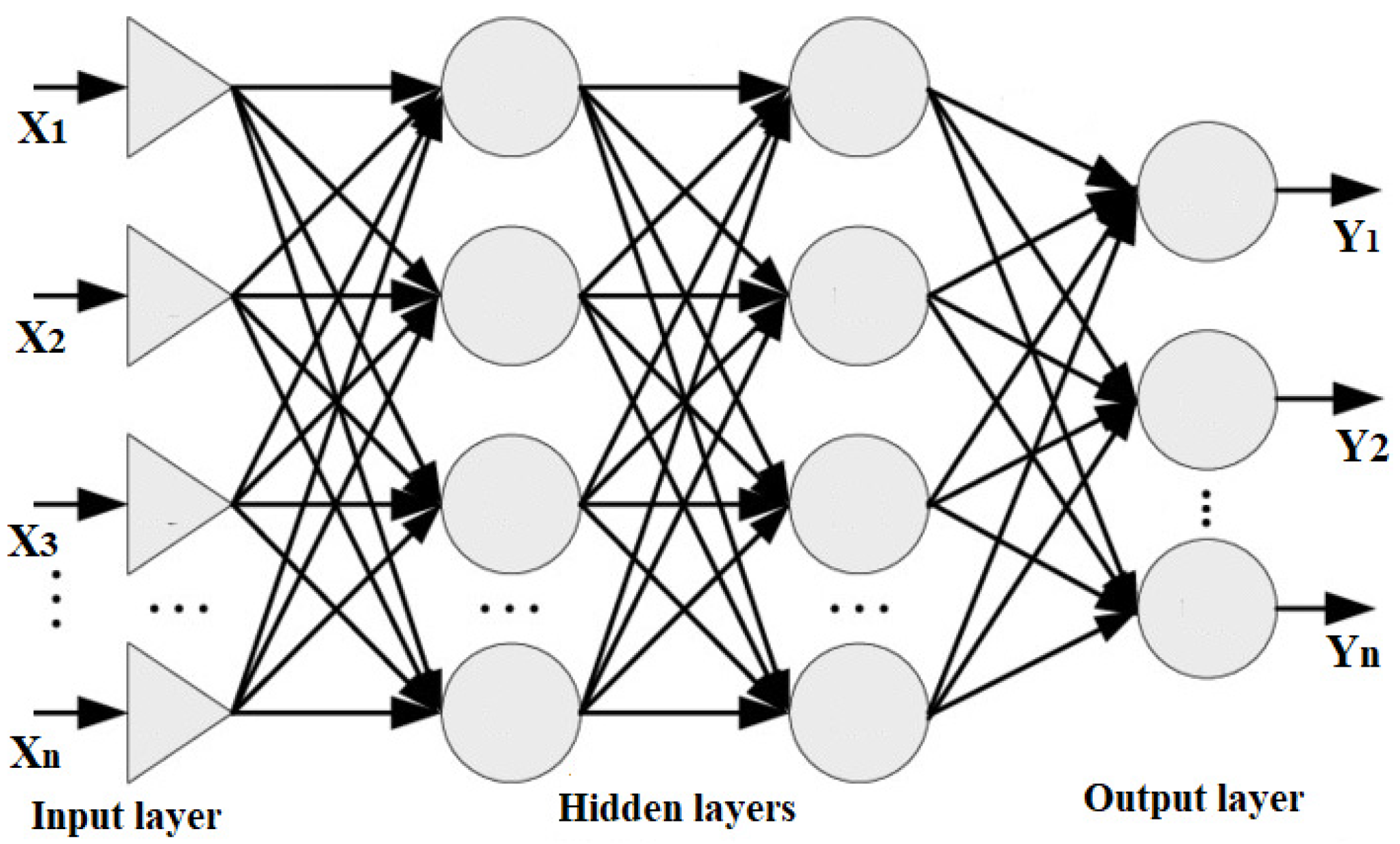
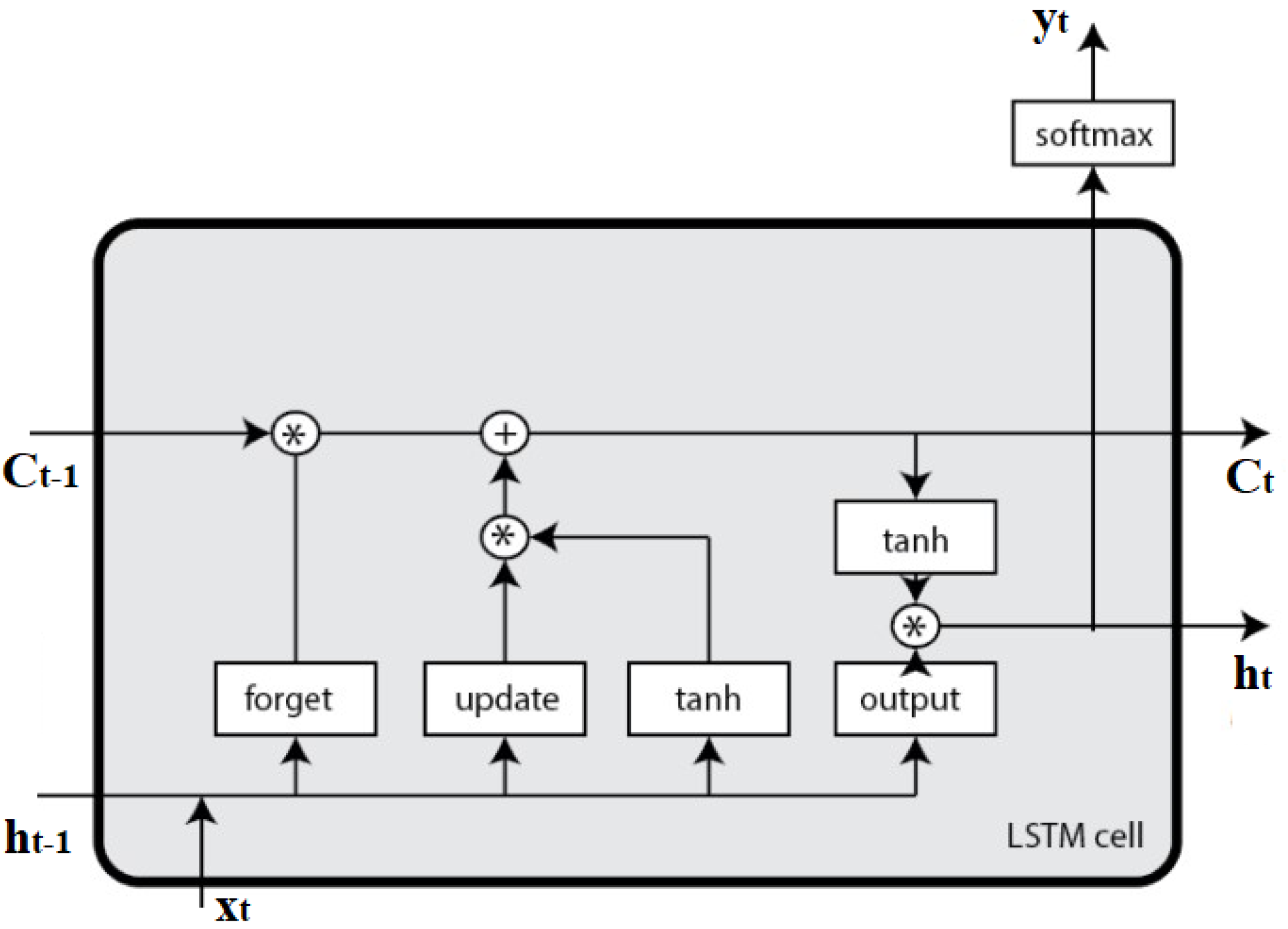

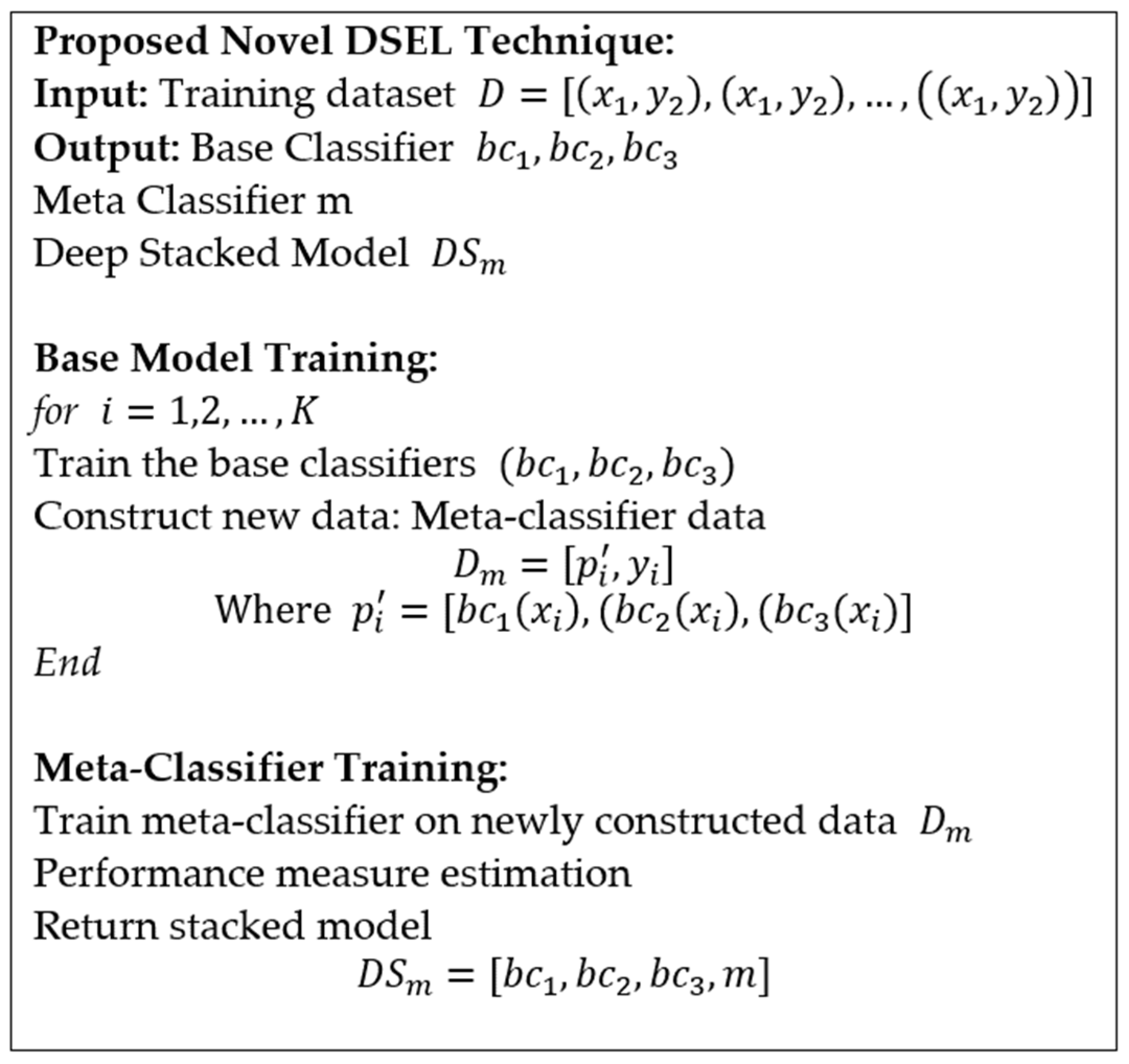
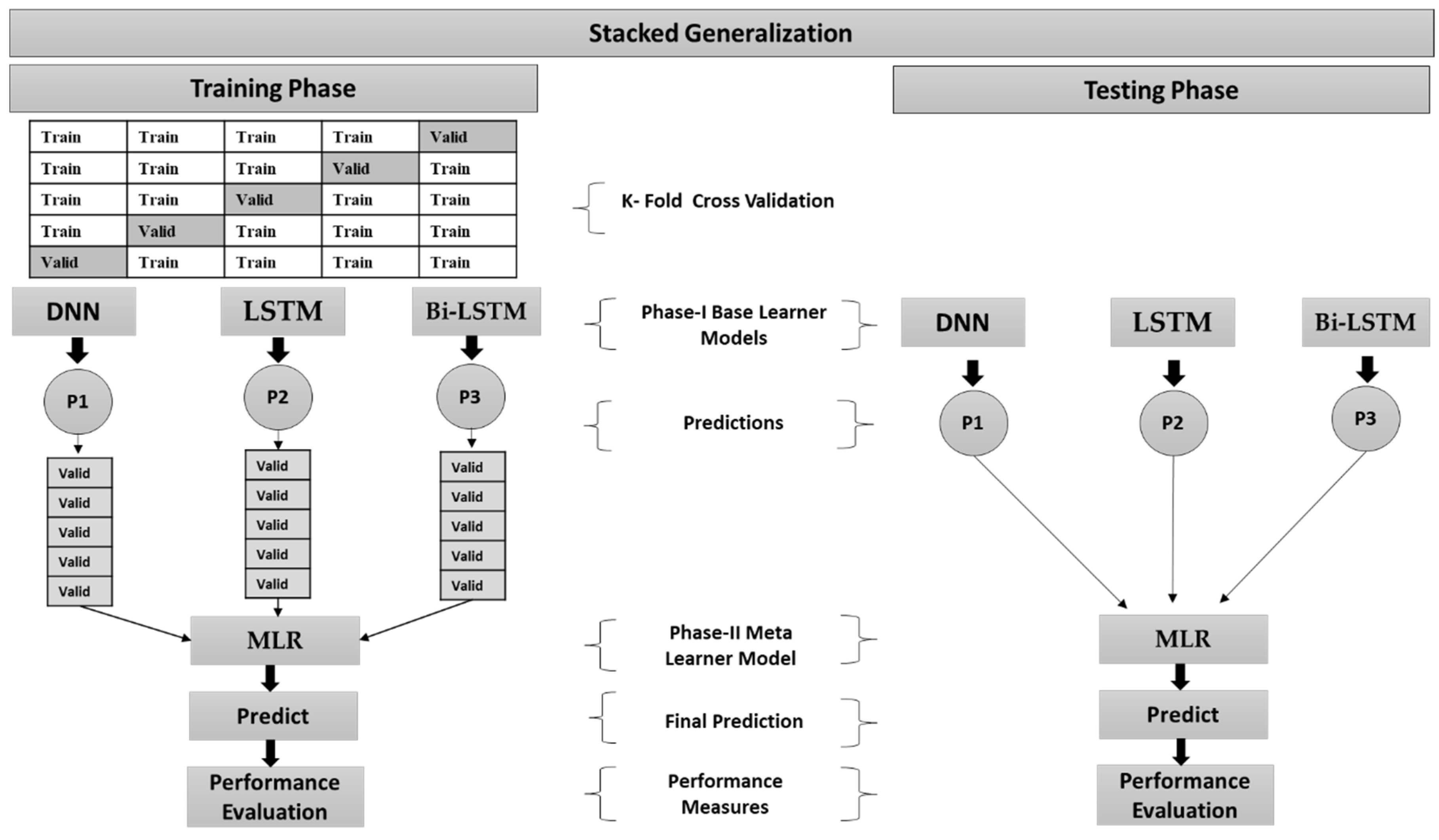
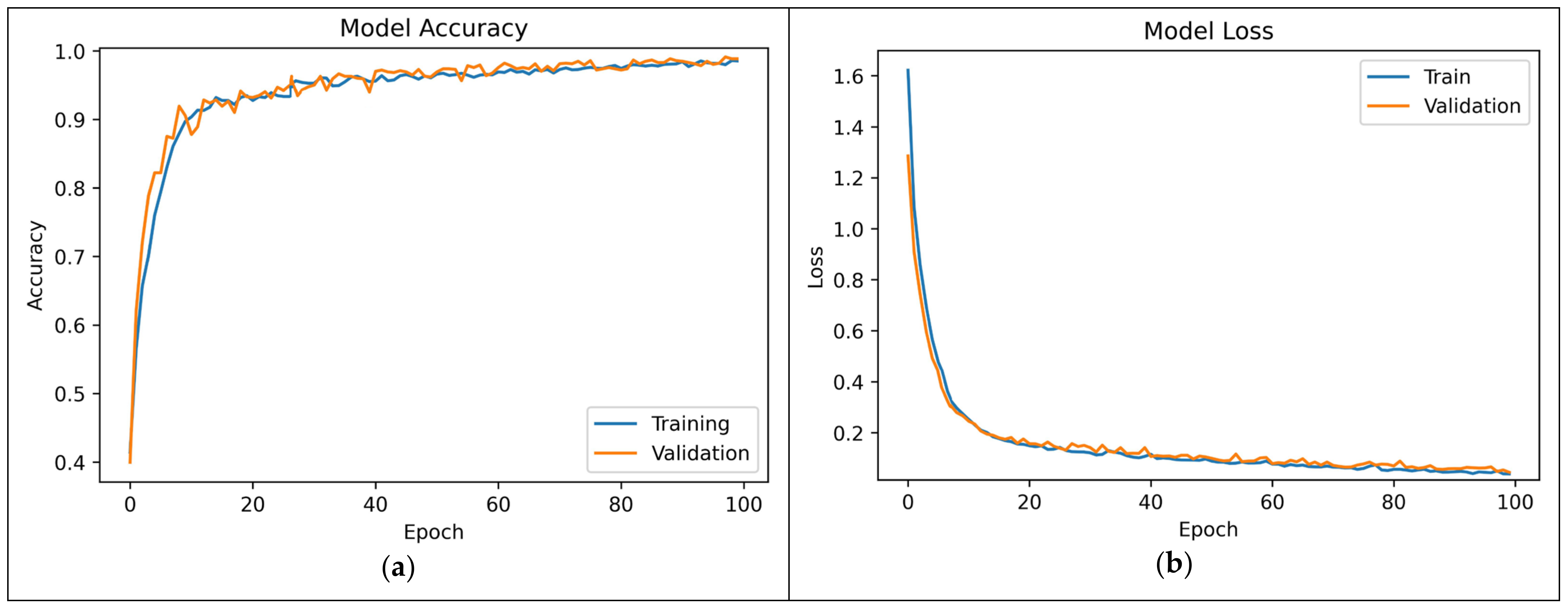
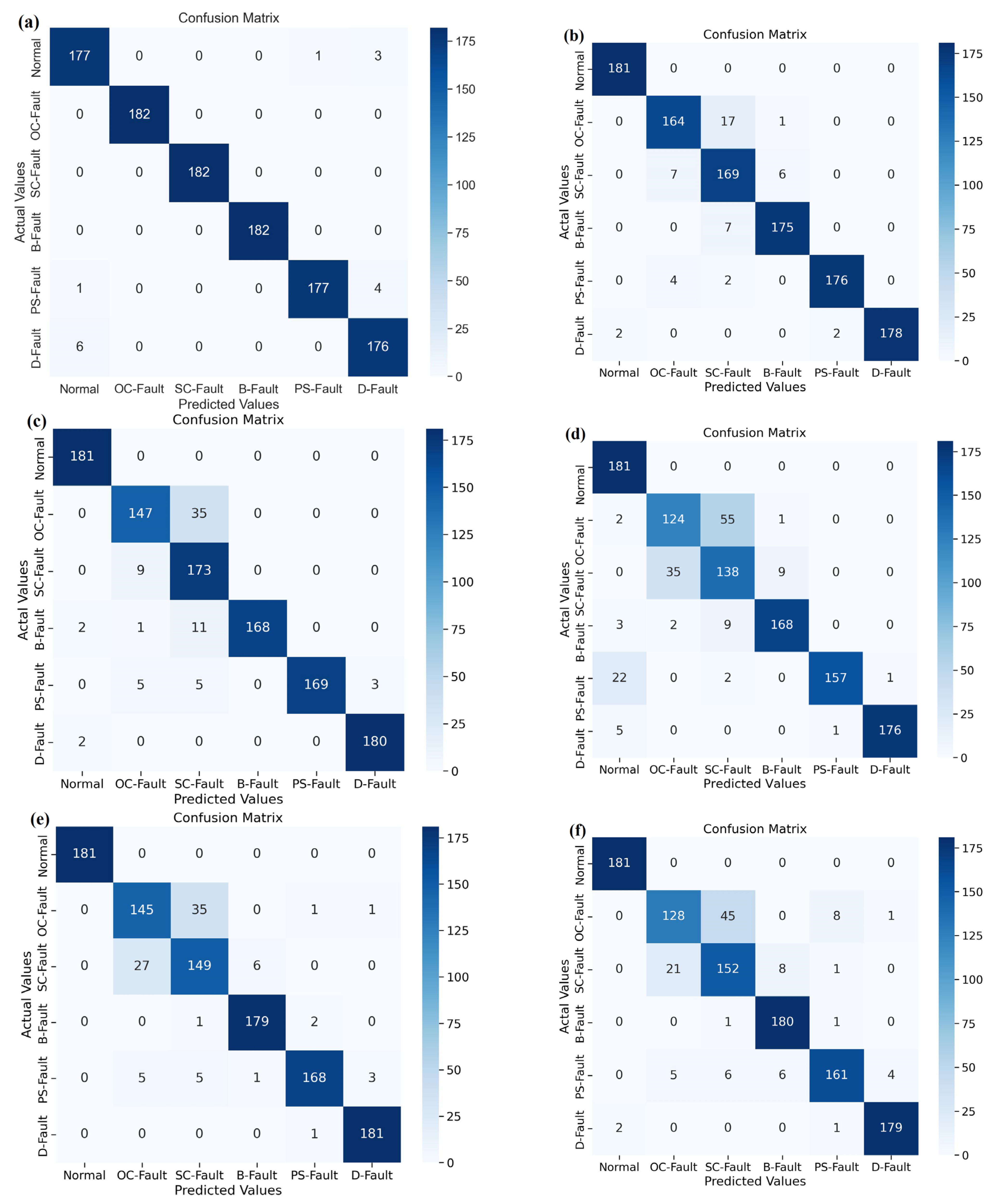


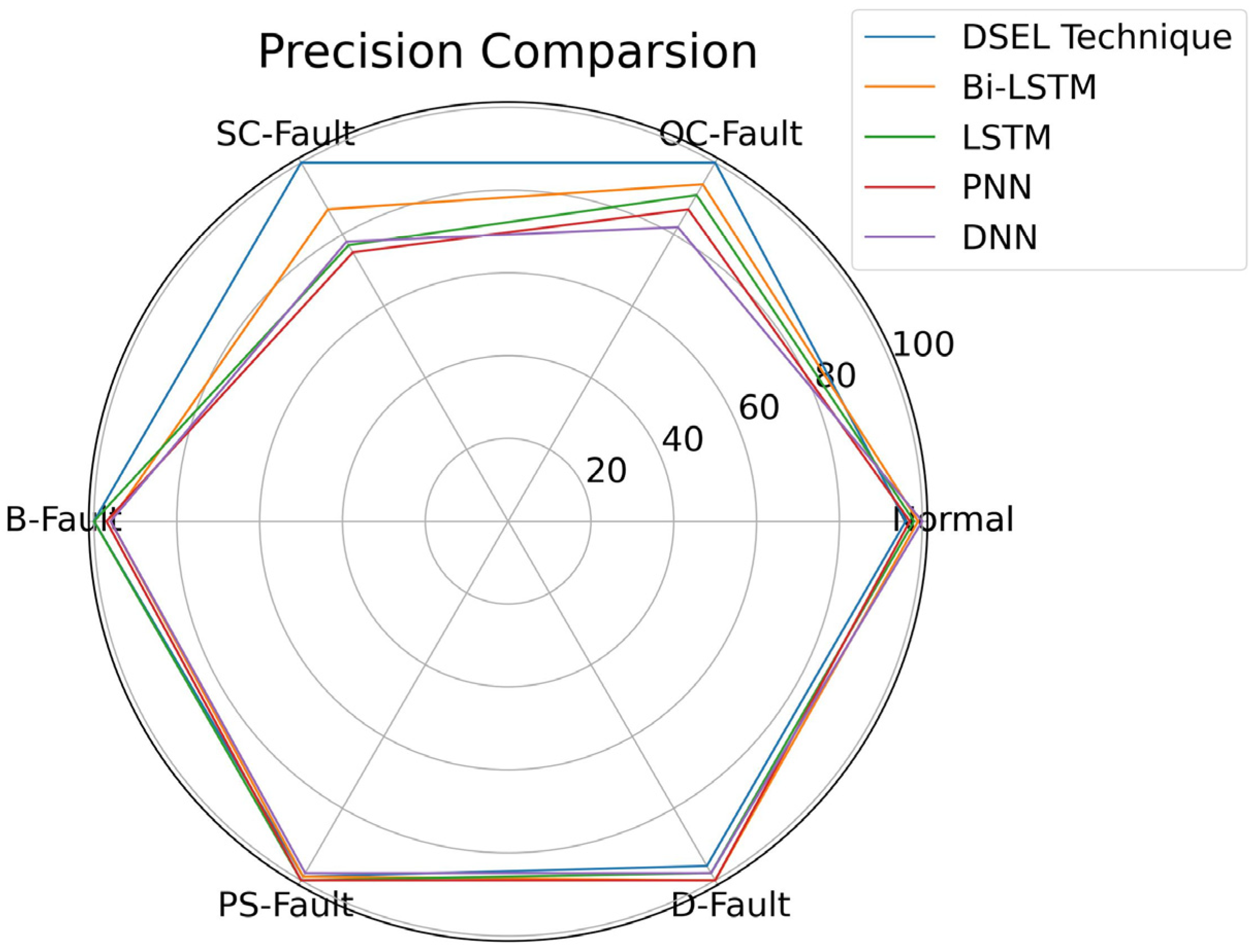
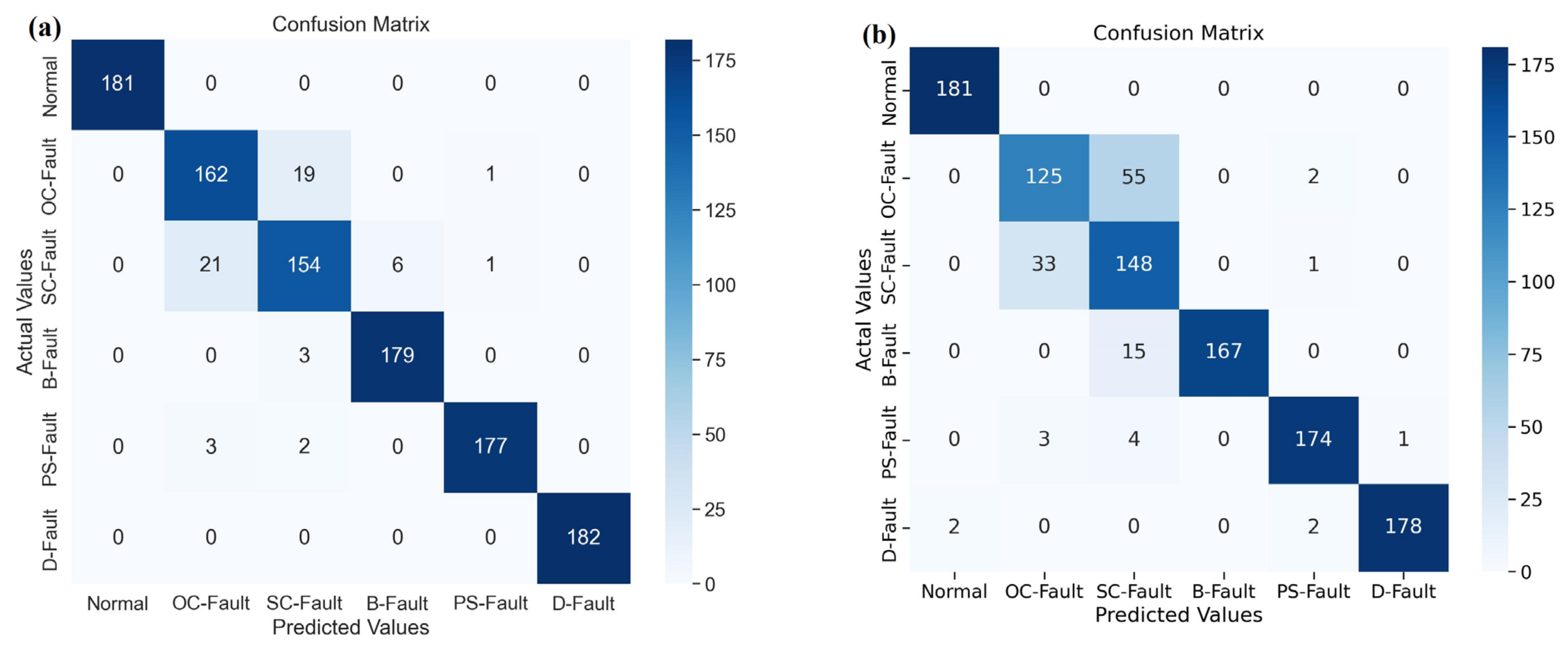
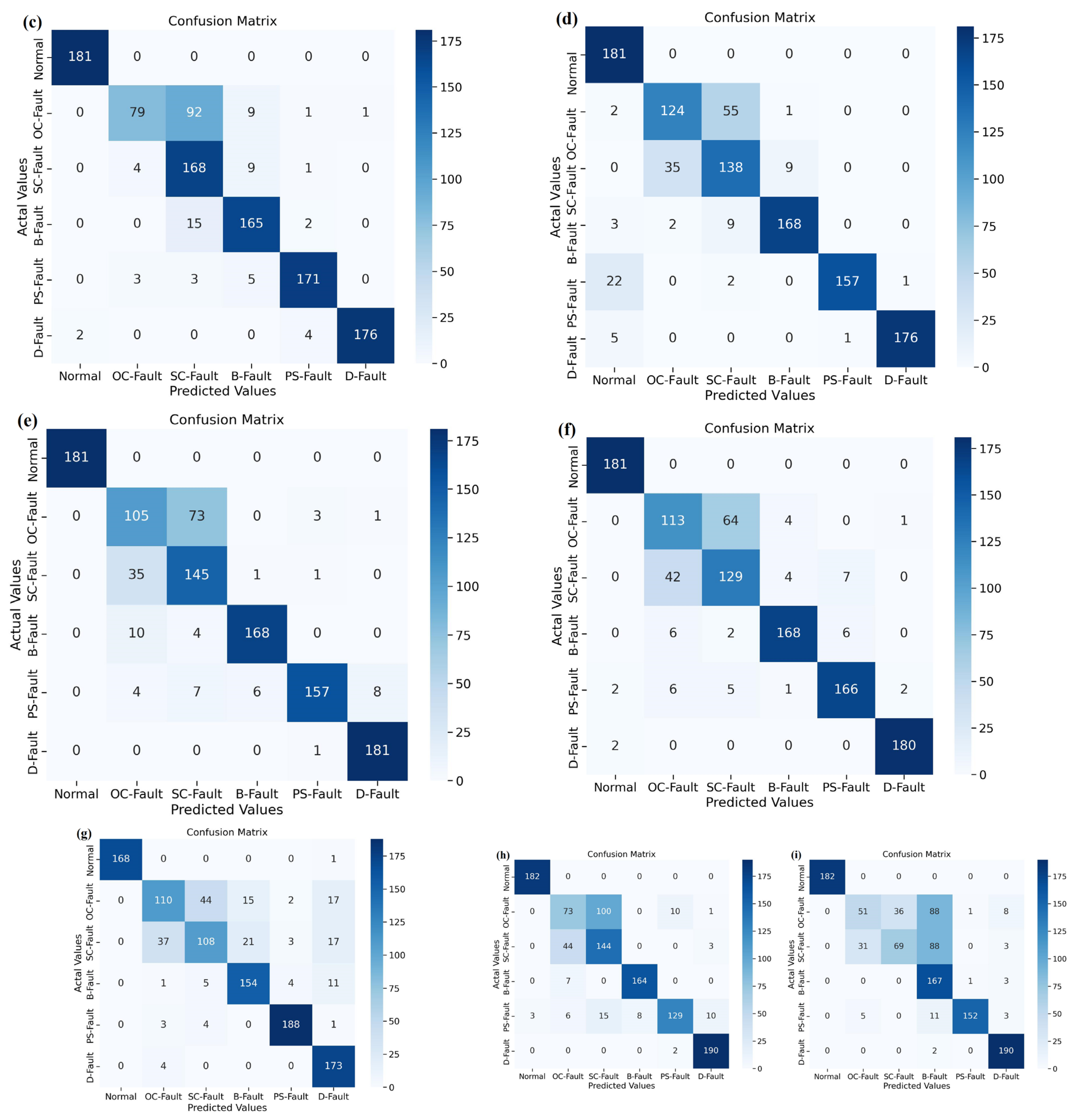
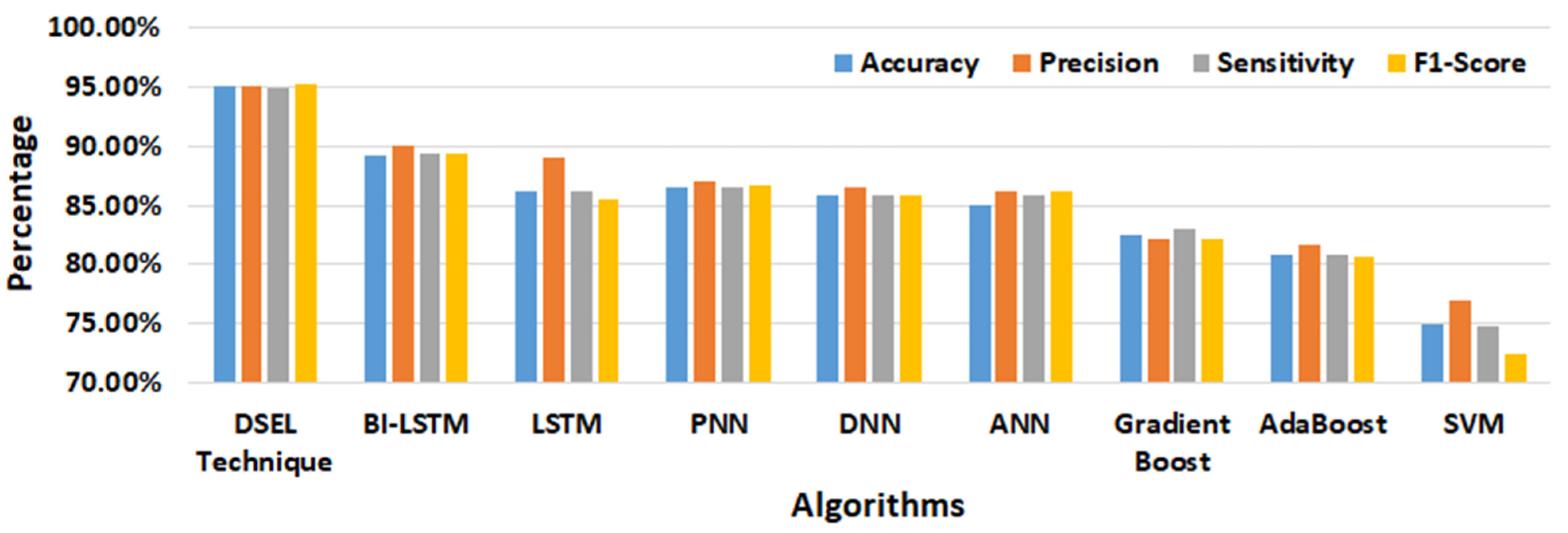
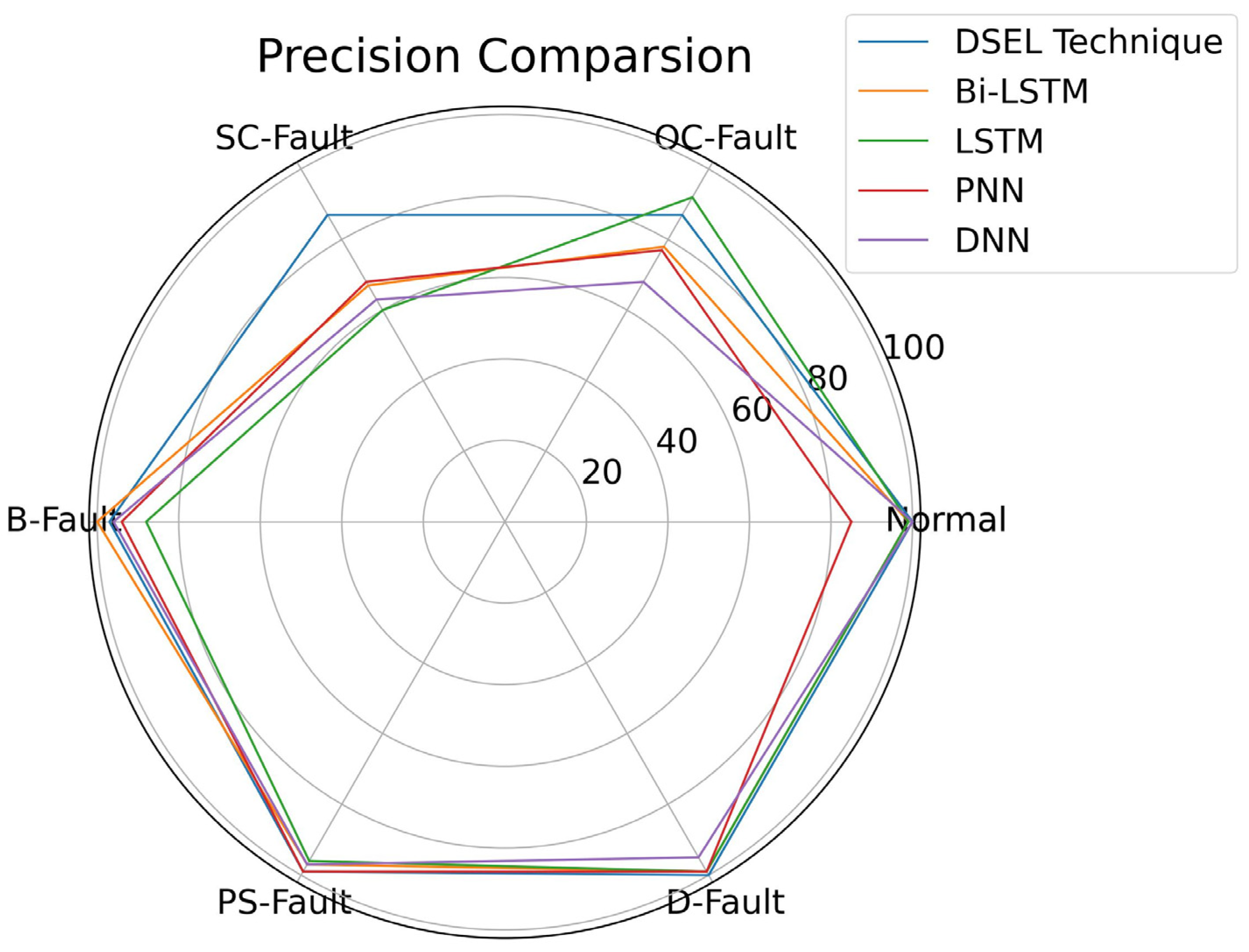
| Parameter | Targeted Values |
|---|---|
| Temperature | 0 to 60 °C at a step change of 5 °C |
| Irradiance | 100 to 1000 W/m2 at a step change of 30 |
| Percentage of Partial Shading | 30% to 70% at a step change of 15 |
| High Impedances Values | 25 Ω, 50 Ω, 75 Ω, 100 Ω, 150 Ω, 200 Ω |
| Fault Impedance | 0 to 15 Ω at a step change of 5 |
| Model | Hyperparatmeters | Grid Search | Optimal Parameters |
|---|---|---|---|
| DNN | Hidden layers | {1, 2, 3, 4, 5} | 2 |
| Learning Rate | {0.0001, 0.001, 0.01, 0.1, 0.2} | 0.001 | |
| Input Activation Fuction | {“relu”, “sigmoid”, “tanh”, “linear”} | Relu | |
| Output Activation Fuction | {“relu”, “sigmoid”, “tanh”, “softmax”} | Softmax | |
| Optimizer | {“SGD”, “rmsprop”, “adagrad”, “adam”} | Adam | |
| Epoches | {25, 50, 75, 100, 125} | 125 | |
| Batch Size | {10, 16, 24, 32, 48} | 16 | |
| Loss Function | { “crossentropy”, “relative entropy”, “sparse categorical crossentropy”} | Sparse categorical crossentropy | |
| LSTM | Hidden layers | {1, 2, 3, 4, 5} | 2 |
| Learning Rate | {0.0001, 0.001, 0.01, 0.1, 0.2} | 0.1 | |
| Input Activation Fuction | {“relu”, “sigmoid”, “tanh”, “linear”} | Relu | |
| Output Activation Fuction | {“relu”, “sigmoid”, “tanh”, “softmax”} | Softmax | |
| Optimizer | {“SGD”, “rmsprop”, “adagrad”, “adam”} | Adam | |
| Epoches | {25, 50, 75, 100, 125} | 100 | |
| Batch Size | {10, 16, 24, 32, 48} | 32 | |
| Dropout | {0.3, 0.4, 0.5, 0.6} | 0.5 | |
| Momentum | {0.5, 0.6, 0.7, 0.8, 0.9} | 0.7 | |
| Decay rate | {0.91, 0.93, 0.95, 0.97} | 0.95 | |
| Loss Function | { “crossentropy”, “relative entropy”, “sparse categorical crossentropy”} | Sparse categorical crossentropy | |
| Bi-LSTM | Hidden Layers | {1, 2, 3, 4, 5} | 1 |
| Learning Rate | {0.0001, 0.001, 0.01, 0.1, 0.2} | 0.0001 | |
| Bi-LSTM Nodes | {10, 15, 20, 25, 30} | 30 | |
| Input Activation Fuction | {“relu”, “sigmoid”, “tanh”, “linear”} | Relu | |
| Output Activation Fuction | {“relu”, “sigmoid”, “tanh”, “softmax”} | Softmax | |
| Optimizer | {“SGD”, “rmsprop”, “adagrad”, “adam”} | Adam | |
| Epoches | {25, 50, 75, 100, 125} | 75 | |
| Batch Size | {10, 16, 24, 32, 48} | 32 | |
| Dropout | {0.3, 0.4, 0.5, 0.6} | 0.4 | |
| Momentum | {0.5, 0.6, 0.7, 0.8, 0.9} | 0.6 | |
| Decay rate | {0.91, 0.93, 0.95, 0.97} | 0.97 | |
| Loss Function | { “crossentropy”, “relative entropy”, “sparse categorical crossentropy”} | Sparse categorical crossentropy | |
| MLR | Solver | {“newton-cg”, “sag”, “saga”, and “lbfgs”} | lbfgs |
| Iterations | {20, 50, 80, 100, 130} | 100 | |
| Penalty | {“l1”, “l2”, “elasticnet”, None} | l2 | |
| C-value | [0.001, 0.01, 0.1, 1, 10] | 1 |
| Algorithms | Accuracy | Precision | Sensitivity | F1-Score |
|---|---|---|---|---|
| DSEL Algorithm | 98.62% | 98.52% | 98.66% | 98.50% |
| BI-LSTM | 95.66% | 95.83% | 95.66% | 95.61% |
| LSTM | 93.35% | 94.01% | 93.33% | 93.21% |
| PNN | 92.11% | 92.63% | 92.33% | 92.04% |
| DNN | 91.89% | 91.97% | 92.01% | 91.89% |
| ANN | 90.37% | 90.16% | 89.98% | 89.83% |
| Gradient Boost | 87.83% | 87.83% | 87.83% | 87.16% |
| AdaBoost | 85.26% | 86.88% | 85.29% | 84.83% |
| SVM | 82. 75% | 82.66% | 82.83% | 82.33% |
| Algorithms | Accuracy | Precision | Sensitivity | F1-Score |
|---|---|---|---|---|
| DSEL Algorithm | 94.87% | 95.10% | 94.87% | 95.06% |
| BI-LSTM | 89.18% | 90.11% | 89.33% | 89.33% |
| LSTM | 86.15% | 89.08% | 86.16% | 85.57% |
| PNN | 86.53% | 87.03% | 86.53% | 86.72% |
| DNN | 85.88% | 86.50% | 85.83% | 85.89% |
| ANN | 84.98% | 86.16% | 85.88% | 86.17% |
| Gradient Boost | 82.58% | 82.19% | 82.94% | 82.16% |
| AdaBoost | 80.84% | 81.68% | 80.81% | 80.66% |
| SVM | 74.87% | 76.95% | 74.86% | 72.50% |
Disclaimer/Publisher’s Note: The statements, opinions and data contained in all publications are solely those of the individual author(s) and contributor(s) and not of MDPI and/or the editor(s). MDPI and/or the editor(s) disclaim responsibility for any injury to people or property resulting from any ideas, methods, instructions or products referred to in the content. |
© 2023 by the authors. Licensee MDPI, Basel, Switzerland. This article is an open access article distributed under the terms and conditions of the Creative Commons Attribution (CC BY) license (https://creativecommons.org/licenses/by/4.0/).
Share and Cite
Lodhi, E.; Wang, F.-Y.; Xiong, G.; Zhu, L.; Tamir, T.S.; Rehman, W.U.; Khan, M.A. A Novel Deep Stack-Based Ensemble Learning Approach for Fault Detection and Classification in Photovoltaic Arrays. Remote Sens. 2023, 15, 1277. https://doi.org/10.3390/rs15051277
Lodhi E, Wang F-Y, Xiong G, Zhu L, Tamir TS, Rehman WU, Khan MA. A Novel Deep Stack-Based Ensemble Learning Approach for Fault Detection and Classification in Photovoltaic Arrays. Remote Sensing. 2023; 15(5):1277. https://doi.org/10.3390/rs15051277
Chicago/Turabian StyleLodhi, Ehtisham, Fei-Yue Wang, Gang Xiong, Lingjian Zhu, Tariku Sinshaw Tamir, Waheed Ur Rehman, and M. Adil Khan. 2023. "A Novel Deep Stack-Based Ensemble Learning Approach for Fault Detection and Classification in Photovoltaic Arrays" Remote Sensing 15, no. 5: 1277. https://doi.org/10.3390/rs15051277
APA StyleLodhi, E., Wang, F.-Y., Xiong, G., Zhu, L., Tamir, T. S., Rehman, W. U., & Khan, M. A. (2023). A Novel Deep Stack-Based Ensemble Learning Approach for Fault Detection and Classification in Photovoltaic Arrays. Remote Sensing, 15(5), 1277. https://doi.org/10.3390/rs15051277








